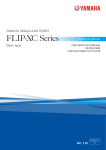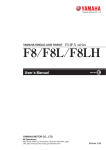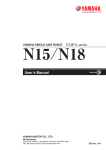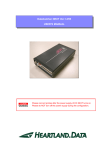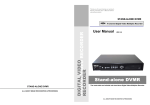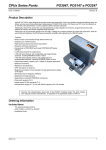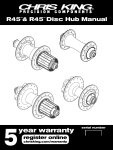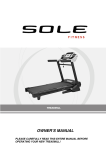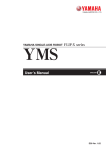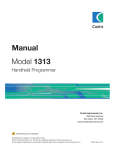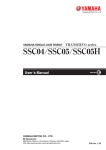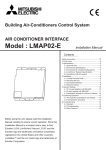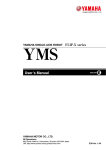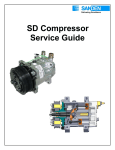Download FLIP-XC User`s Manual
Transcript
YAMAHA SINGLE-AXIS ROBOT FLIP-X series FLIP-XC User’s Manual ENGLISH E YAMAHA MOTOR CO., LTD. IM Operations 882 Soude, Naka-ku, Hamamatsu, Shizuoka 435-0054.Japan URL http://www.yamaha-motor.jp/robot/index.html E27-Ver. 2.03 Thanks for your purchasing YAMAHA single-axis robot FLIP-X series. Before using this robot, read the following notes and set the origin position. The “X” series single-axis and XY robots use absolute position detectors that do not require return-to-origin after turning on the controller power. However, when the controller power is turned on in the following cases, return-to-origin must be performed just the very first time. (1) (2) (3) (4) When When When When robot cable was first connected after delivery from YAMAHA. robot cable was disconnected from the controller and then reconnected. no absolute battery is connected. a motor or cable was replaced. At this point, any of the following errors is issued immediately after controller power is turned on, but this is not a malfunction. The controller will operate normally by restarting. When using an SR1 controller: 15 : FEEDBACK ERROR 2 23 : ABS.BAT.L-VOLTAGE 24 : ABS.DATA.ERROR … etc. When using an RCX240, RCX222 controller: 17.81 : D?.ABS.battery wire breakage 17.92 : D?.Resolver disconnected during power off 17.93 : D?.Position backup counter overflow … etc. When using an TS-X controller: 82 ENCODER ERROR 83 ABS. ENCODER ERR. 8A ABS. BATTERY ERR. 8B ABS. COUNT ERROR 8D ABS. OVERFLOW ERR. … etc. Before using the single-axis robot FLIP-X series (Be sure to read the following notes.) Before using the single-axis robot FLIP-X series (Be sure to read the following notes.) Setting the origin position Before using the single-axis robot FLIP-X series (Be sure to read the following notes.) Set the origin position while referring to the following section in the robot controller user's manual. When using an SR1 controller: See "9.1.1 Return-to-origin by the search method" in Chapter 9 of the "HPB Operation Guide" section. When using an RCX240 controller: See "11.9 Absolute reset" in Chapter 4. When using an RCX222 controller: See "11.8 Absolute reset" in Chapter 4. When using an TS-X controller: See "6.2 Origin search (return-to-origin)" in "6. Operating the robot" of the "HT1 Operation Guide" section. c CAUTION Changing the origin position to the opposite side of the initial position may cause a position shift or robot breakdowns, so use caution. Avoid changing the origin detection method since it is dangerous in some cases. If the origin position must be changed, please consult our sales office or dealer. General Contents General Contents Introduction Chapter 1 Using the Robot Safely 1-1 Safety information 1-1 1-2 Essential precautions 1-3 1-3 Industrial robot operating and maintenance personnel 1-9 1-4 Robot safety functions 1-10 1-5 Safety measures for the system 1-11 1-6 Trial operation 1-11 1-7 Work within the safety enclosure 1-12 1-8 Automatic operation 1-13 1-9 Warranty 1-13 Chapter 2 Functions 2-1 Robot manipulator (part names) 2-1 Chapter 3 Installation 3-1 Robot installation conditions 3-1-1 3-1-2 Installation environments Installation base 3-2 Installation 3-2-1 3-2-2 3-2-3 Checking the product Moving the robot Installing the robot 3-2-3-1 Installing the C4/C4H, C5/C5H and C6 3-2-3-2 Installing the C10, C14/C14H, C17/C17L and C20 3-1 3-1 3-2 3-3 3-3 3-4 3-5 3-5 3-7 3-3 Protective bonding 3-9 3-4 Robot cable connection 3-10 3-5 Suction hoses connection 3-12 i General Contents 3-6 Setting the operating conditions 3-6-1 3-6-2 3-6-3 Payload Maximum speed setting Duty 3-13 3-13 3-14 3-14 Chapter 4 Adjusting the Robot 4-1 Overview 4-1 4-2 Safety precautions 4-1 4-3 Adjusting shutter looseness 4-2 4-3-1 4-3-2 Adjusting the shutter looseness (C4/C4H, C5/C5H, C6) 4-2 Adjusting the shutter looseness (C10, C14/C14H, C17/C17L, C20) 4-3 Chapter 5 Periodic Inspection and Maintenance 5-1 Before beginning work 5-1 5-2 Precautions 5-1 5-3 Periodic inspection 5-2 5-3-1 5-3-2 5-3-3 Daily inspection Three-Month inspection Six-Month inspection 5-2 5-3 5-6 5-4 Applying grease 5-9 5-4-1 5-4-2 Replenishing grease (C4/C4H, C5/C5H, C6) Replenishing grease (C10, C14/C14H, C17/C17H, C20) 5-10 5-16 5-5 Replacing the shutter 5-19 Chapter 6 Specifications 6-1 AC servo motor specifications 6-1 6-1-1 6-1-2 6-1-3 AC servo motor termination (C4/C4H, C5/C5H) 6-1 Brake cable specifications (C4/C4H, C5/C5H, C6) 6-2 AC servo motor termination (C6, C10, C14/C14H, C17/C17L, C20) 6-2 6-2 Robot cables 6-2-1 6-2-2 Robot cables (C4/C4H, C5/C5H) Robot cables (C6, C10, C14/C14H, C17/C17L, C20) 6-4 6-4 6-5 Chapter 7 Troubleshooting 7-1 ii Positioning error 7-1 7-2 Feedback error 7-2 8-1 About machine reference 8-1 8-2 Equation of moment of inertia calculation 8-2 8-3 Duty 8-3 General Contents Chapter 8 Appendix iii MEMO iv Introduction • This user's manual should be used with the robot and considered an integral part of it. When the robot is moved, transferred or sold, send this manual to the new user along with the robot. Be sure to explain to the new user the need to read through this manual. • Specifications of robot models other than standard models may be omitted in this manual if they are common to those of standard models. In this case, refer to the specifications of standard models. • For details on specific operation of the robot, refer to the separate user’s manual for the robot controller being used. NOTES ◆ The contents of this manual are subject to change without prior notice. ◆ While every effort has been made to ensure the contents of this manual are correct, please contact us if you find any part of this manual to be unclear, confusing or inaccurate. YAMAHA MOTOR CO., LTD. IM Operations Introduction The YAMAHA FLIP-X series is a family of single-axis industrial robots that use the absolute positioning method as a standard feature to improve ease of use, resistance to environmental conditions and maintenance work. A wide varaiety of product lineup allows you to select the desired robot model that best matches your application. This user's manual describes the safety measures, handling, adjustment and maintenance of FLIP-X series robots for correct, safe and effective use. Be sure to read this manual carefully before installing the robot. Even after you have read this manual, keep it in a safe and convenient place for future reference. MEMO Chapter 1 Using the Robot Safely Contents 1-1 Safety information 1-1 1-2 Essential precautions 1-3 1-3 Industrial robot operating and maintenance personnel 1-9 1-4 Robot safety functions 1-10 1-5 Safety measures for the system 1-11 1-6 Trial operation 1-11 1-7 Work within the safety enclosure 1-12 1-8 Automatic operation 1-13 1-9 Warranty 1-13 1-1 Safety information 1-1 Safety information Warning symbols and signal words used in this manual are classified as explained below. Make sure that you fully understand the meaning of each symbol and comply with the instructions. w w c n DANGER FAILURE TO FOLLOW DANGER INSTRUCTIONS WILL RESULT IN SEVERE INJURY OR DEATH TO THE ROBOT OPERATOR, BYSTANDERS OR PERSONS INSPECTING OR REPAIRING THE ROBOT. WARNING FAILURE TO FOLLOW WARNING INSTRUCTIONS COULD RESULT IN SEVERE INJURY OR DEATH TO THE ROBOT OPERATOR, BYSTANDERS OR PERSONS INSPECTING OR REPAIRING THE ROBOT. CAUTION Failure to follow CAUTION instructions may result in injury to the robot operator, bystanders or persons inspecting or repairing the robot, or damage to the robot and/or robot controller. NOTE Explains the key point in the operation in a simple and clear manner. 1-1 1 Using the Robot Safely Industrial robots are highly programmable, mechanical devices that provide a large degree of freedom when performing various manipulative tasks. To ensure correct and safe use of YAMAHA industrial robots, carefully read this manual and make yourself well acquainted with the contents. FOLLOW THE WARNINGS, CAUTIONS AND INSTRUCTIONS included in this manual. Failure to take necessary safety measures or mishandling due to not following the instructions in this manual may result in trouble or damage to the robot and injury to personnel (robot operator or service personnel) including fatal accidents. 1-1 Safety information Refer to the user's manual by any of the following methods to operate or adjust the robot safely and correctly. 1 1. Operate or adjust the robot while referring to the printed version of the user's manual (available for an additional fee). Using the Robot Safely 2. Operate or adjust the robot while viewing the CD-ROM version of the user's manual on your computer screen. 3. Operate or adjust the robot while referring to a printout of the necessary pages from the CD-ROM version of the user's manual. It is not possible to list all safety items in detail within the limited space of this manual. So it is essential that the user have a full knowledge of basic safety rules and also that the operator makes correct judgments on safety procedures during operation. For specific safety information and standards, refer to the applicable local regulations and comply with the instructions. This manual and warning labels supplied with or attached to the robot are written in English. Unless the robot operators or service personnel understand English, do not permit them to handle the robot. * Cautions regarding the official language of EU countries For equipment that will be installed in EU countries, the language used for the user's manuals, CE declarations, and operation screen characters is English only. Warning labels only have pictograms or else include warning messages in English. In the latter case, Japanese messages might be added. 1-2 1-2 Essential precautions 1-2 Essential precautions (1) Obser ve the following cautions during automatic operation. • Install a safeguard (safety enclosure) to keep any person from entering within the movement range of the robot and suffering injury due to being struck by moving parts. • Install a safety interlock that triggers emergency stop when the door or panel is opened. • Install a safety enclosure so that no one can enter inside except from doors or panels equipped with safety interlocks. • Warning labels 1 are supplied with the robot and should be affixed to conspicuous spots on doors or panels equipped with safety interlocks. w DANGER SERIOUS INJURY OR DEATH WILL RESULT FROM IMPACT WITH MOVING ROBOT. • KEEP OUTSIDE OF GUARD DURING OPERATION. • LOCK OUT POWER BEFORE APPROACHING ROBOT. Warning label 1 DANGER Serious injury or death will result from impact with moving robot. s Keep outside of guard during operation. s Lock out power before approaching robot. (2) Use caution to prevent hands or fingers from being pinched or crushed. Warning label 2 is affixed to the robot. Use caution to prevent hands or fingers from being pinched or crushed by the moving parts when carrying the robot or during teaching. w WARNING MOVING PARTS CAN PINCH OR CRUSH HANDS. KEEP HANDS AWAY FROM ROBOT ARMS. 1-3 1 Using the Robot Safely Particularly important cautions for handling or operating the robot are described below. In addition, precautions during installation, operation, inspection and maintenance are also provided in each chapter. Be sure to comply with these instructions to ensure safe use of the robot. 1-2 Essential precautions Warning label 2 1 WARNING Using the Robot Safely Moving parts can pinch or crush. Keep hands away from robot arms. (3) Follow the instructions on warning labels and in this manual. • Be sure to read the warning labels and this manual carefully and make sure you thoroughly understand their contents before attempting installation and operation of the robot. • Before starting robot operation, be sure to reread the procedures and cautions relating to your work as well as descriptions in this chapter (Chapter 1, "Using the Robot Safely"). • Never install, adjust, inspect or service the robot in any manner that does not comply with the instructions in this manual. • The warning labels 3 are supplied with the robot and should be affixed to the robot or conspicuous spots near the robot. w WARNING IMPROPER INSTALLATION OR OPERATION CAN RESULT IN SERIOUS INJURY OR DEATH. READ THE USER'S MANUAL AND ALL WARNING LABELS BEFORE INSTALLATION OR OPERATION. Warning label 3 WARNING Improper Installation or operation can result in serious injury or death. Read user's(owner's) manual and all warning labels before operation. (4) Do not remove, alter or stain the warning labels. w 1-4 WARNING IF WARNING LABELS ARE REMOVED OR DIFFICULT TO SEE, THEN ESSENTIAL PRECAUTIONS MIGHT NOT BE TAKEN, RESULTING IN ACCIDENTS. • DO NOT REMOVE, ALTER OR STAIN THE WARNING LABELS ON THE ROBOT. • DO NOT ALLOW THE WARNING LABELS TO BE HIDDEN BY DEVICES INSTALLED ONTO THE ROBOT BY THE USER. • PROVIDE PROPER LIGHTING SO THAT THE SYMBOLS AND INSTRUCTIONS ON THE WARNING LABELS CAN BE CLEARLY SEEN EVEN FROM OUTSIDE THE SAFETY ENCLOSURE. 1-2 Essential precautions (5) Do not use the robot in environments containing inflammable gas, etc. w Do not use the robot in locations possibly subject to electromagnetic interference, etc. w (7) Use caution when releasing the brake of a vertical use robot. w (8) WARNING THE VERTICAL AXIS WILL SLIDE DOWN WHEN THE BRAKE IS RELEASED, CAUSING A HAZARDOUS SITUATION. • PRESS THE EMERGENCY STOP BUTTON AND PROP UP THE VERTICAL AXIS WITH A SUPPORT STAND BEFORE RELEASING THE BRAKE. • BE CAREFUL NOT TO LET YOUR BODY GET CAUGHT BETWEEN THE VERTICAL AXIS AND INSTALLATION BASE WHEN RELEASING THE BRAKE TO PERFORM DIRECT TEACH. Provide safety measures for end effector (gripper, etc.). w (9) WARNING AVOID USING THE ROBOT IN LOCATIONS SUBJECT TO ELECTROMAGNETIC INTERFERENCE, ELECTROSTATIC DISCHARGE OR RADIO FREQUENCY INTERFERENCE. MALFUNCTIONS MIGHT OTHERWISE OCCUR. WARNING • END EFFECTORS MUST BE DESIGNED AND MANUFACTURED SO THAT THEY CREATE NO HAZARDS (FOR EXAMPLE, A WORKPIECE THAT COMES LOOSE) EVEN IF POWER (ELECTRICITY, AIR PRESSURE, ETC.) IS SHUT OFF OR POWER FLUCTUATIONS OCCUR. • IF THERE IS A POSSIBLE DANGER THAT THE OBJECT GRIPPED BY THE END EFFECTOR MAY FLY OFF OR DROP, THEN PROVIDE APPROPRIATE SAFETY PROTECTION TAKING INTO ACCOUNT THE OBJECT SIZE, WEIGHT, TEMPERATURE AND CHEMICAL PROPERTIES. Use caution when removing the motor. (Vertical use robots) w WARNING THE VERTICAL AXIS WILL SLIDE DOWN WHEN THE MOTOR IS RELEASED, CAUSING A HAZARDOUS SITUATION. • TURN OFF THE ROBOT CONTROLLER AND PROP UP THE VERTICAL AXIS WITH A SUPPORT STAND BEFORE REMOVING THE MOTOR. • BE CAREFUL NOT TO LET YOUR BODY GET CAUGHT BETWEEN THE VERTICAL AXIS PARTS AND INSTALLATION BASE. 1-5 1 Using the Robot Safely (6) WARNING • THIS ROBOT WAS NOT DESIGNED FOR OPERATION IN ENVIRONMENTS WHERE INFLAMMABLE OR EXPLOSIVE SUBSTANCES ARE PRESENT. • DO NOT USE THE ROBOT IN ENVIRONMENTS CONTAINING INFLAMMABLE GAS, DUST OR LIQUIDS. EXPLOSIONS OR FIRE MIGHT OTHERWISE RESULT. 1-2 Essential precautions (10) Be careful not to touch the motor or speed reduction gear casing when hot. 1 w Using the Robot Safely WARNING The motor and speed reduction gear casing are extremely hot after automatic operation, so burns may occur if these are touched. Before handling these parts during inspection or servicing, turn off the controller, wait for a while and check that the parts have cooled. (11) Take the following safety precautions during inspection of controller. w WARNING • WHEN YOU NEED TO TOUCH THE TERMINALS OR CONNECTORS ON THE OUTSIDE OF THE CONTROLLER DURING INSPECTION, ALWAYS FIRST TURN OFF THE CONTROLLER POWER SWITCH AND ALSO THE POWER SOURCE IN ORDER TO PREVENT POSSIBLE ELECTRICAL SHOCK. • NEVER TOUCH ANY INTERNAL PARTS OF THE CONTROLLER. • REFER TO THE "YAMAHA ROBOT CONTROLLER USER'S MANUAL" FOR PRECAUTIONS ON HANDLING THE CONTROLLER. (12) Use caution not to touch the controllerl cooling fan. w WARNING • BODILY INJURY MAY OCCUR FROM COMING INTO CONTACT WITH THE COOLING FAN WHILE IT IS ROTATING. • WHEN REMOVING THE FAN COVER FOR INSPECTION, FIRST TURN OFF THE CONTROLLER AND MAKE SURE THE FAN HAS STOPPED. (13) Consult us for corrective action when the robot is damaged or malfunctions occur. w WARNING IF ANY PART OF THE ROBOT IS DAMAGED OR ANY MALFUNCTION OCCURS, CONTINUING THE OPERATION MAY BE VERY DANGEROUS. PLEASE CONSULT YOUR YAMAHA SALES OFFICE OR DEALER FOR CORRECTIVE ACTION. Damage or Trouble Possible Danger Damage to machine harness or robot cable Electrical shock, malfunction of robot Damage to exterior of robot Flying outwards of damaged parts during robot operation Abnormal operation of robot (positioning error, excessive vibration, etc.) Malfunction of robot Z-axis brake trouble Dropping of load (14) Protective bonding w 1-6 WARNING BE SURE TO GROUND THE ROBOT AND CONTROLLER TO PREVENT ELECTRICAL SHOCK. 1-2 Essential precautions (15) Be sure to make correct parameter settings. c CAUTION The robot must be operated with correct tolerable moment of inertia and acceleration coefficients according to the manipulator tip mass and moment of inertia. If these are not correct, drive unit service life may end prematurely, and damage to robot parts or residual vibration during positioning may result. 1 Using the Robot Safely (16) Do not use the robot for tasks requiring motor thrust. c CAUTION Avoid using the belt-driven type robots for tasks which utilize motor thrust (pressfitting, burr removal, etc.). These tasks may cause malfunctions in the robot. (17) Follow the specified procedures when installing, adjusting or inspecting the robot. w WARNING ALWAYS FOLLOW THE SPECIFIED PROCEDURES WHEN INSTALLING, ADJUSTING OR INSPECTING THE ROBOT. NEVER ATTEMPT ANY PROCEDURE NOT DESCRIBED IN THIS MANUAL. (18) Do not attempt any repair, parts replacement and modification. w WARNING DO NOT ATTEMPT ANY REPAIR, PARTS REPLACEMENT AND MODIFICATION UNLESS DESCRIBED IN THIS MANUAL. THESE WORKS REQUIRE TECHNICAL KNOWLEDGE AND SKILL, AND MAY ALSO INVOLVE WORK HAZARDS. (19) Location for installing the controller and the programming box or Handy Terminal The robot controller, programming box, and Handy Terminal should be installed at a location that is outside the robot movement range yet where it is easy to operate and view the robot performing tasks. (20) Protect electrical wiring and hydraulic/pneumatic hoses as needed. Install a cover or similar item to protect the electrical wring and hydraulic/pneumatic hoses from possible damage. (21) Install an operation status light. Install an operation status light (signal light tower, etc.) at an easy-to-see position so the operator will know whether the robot is merely stopped or is in emergency-error stop. 1-7 1-2 Essential precautions (22) Clean work tools, etc. 1 Work tools such as welding guns and paint nozzles which are mounted in the robot arm will preferably be cleaned automatically. (23) Provide adequate lighting. Using the Robot Safely Make sure to provide enough lighting to ensure safety during work. (24) Prevent the gripped object from flying outwards. If the object or workpiece gripped by the robot might fly outward or drop and create a hazard to the operator, then protective equipment should be installed by taking the size, weight, temperature and chemical properties of the object into account. (25) Draw up "work instructions" and makes sure the operator learns them well. Decide on "work instructions" for the following items in cases where personnel must work within the robot movement range to perform teaching, maintenance or inspection. Make sure the workers know these "work instructions" well. (1) Robot operating procedures needed for tasks such as startup procedures and handling switches (2) Robot speeds used during tasks such as teaching (3) Methods for workers to signal each other when two or more workers perform tasks (4) Steps that the worker should take when a problem or emergency occurs (5) Steps to take after the robot has come to a stop when the emergency stop device was triggered, including checks for cancelling the problem or error state and safety checks in order to restart the robot. (6) In cases other than above, the following actions should be taken as needed to prevent hazardous situations due to sudden or unexpected robot operation or faulty robot operation, as listed below. 1. Show a display on the operator panel 2. Ensure the safety of workers performing tasks within the robot movement range 3. Clearly specify position and posture during work Position and posture where worker can constantly check robot movements and immediately move to avoid trouble if an error/problem occurs 4. Install noise prevention measures 5. Use methods for signaling operators of related equipment 6. Use methods to decide that an error has occurred and identify the type of error Implement the "work instructions" according to the type of robot, installation location, and type of work task. When drawing up the "work instructions", make an effort to include opinions from the workers involved, equipment manufacture's technicians, and workplace safety consultants, etc. 1-8 1-3 Industrial robot operating and maintenance personnel (26) Display a sign on operation panel during work (27) Make daily and periodic inspections. (1) Always make sure that daily and periodic inspections are performed, and make a pre-work check to ensure there are no problems with the robot or related equipment. If a problem or abnormality is found, then promptly repair it or take other measures as necessary. (2) When you make periodic inspections or repairs, make a record and store it for at least 3 years. 1-3 Industrial robot operating and maintenance personnel Operators or persons who handle the robot such as for teaching, programming, movement check, inspection, adjustment, and repair must receive appropriate training and also have the skills needed to perform the job correctly and safely. They must read the user's manual carefully to understand its contents before attempting the robot operation. Tasks related to industrial robots (teaching, programming, movement check, inspection, adjustment, repair, etc.) must be performed by qualified persons who meet requirements established by local regulations and safety standards for industrial robots. 1-9 1 Using the Robot Safely Display an easy to understand sign or message on the programming box, Handy Terminal, and operation panel during the job task, to prevent anyone other than the operators for that job task from mistakenly operating a start or selector switch. If needed, take other measures such as locking the cover on the operation panel. 1-4 Robot safety functions 1-4 1 (1) Robot safety functions Overload detection This function detects an overload applied to the motor and shuts off the servo power. Using the Robot Safely (2) Overheat detection This detects an abnormal temperature rise in the controller driver and shuts off the servo power. If an overload or overheat error occurs, take the following measures. 1. Insert a timer in the program. 2. Reduce the acceleration coefficient. (3) Soft limits Soft limits can be set on each axis to limit the working envelope in manual operation after return-to-origin and during automatic operation. No mechanical stopper is provided on the rotating axis. Note: The working envelope is the area limited by soft limits. w (4) WARNING SOFT LIMITS MUST BE SET WITHIN THE MOVEMENT RANGE (MECHANICAL STOPPER). IF THE SOFT LIMIT IS SET OUTSIDE THE MOVEMENT RANGE, THE ROBOT AXIS MAY COLLIDE WITH THE MECHANICAL STOPPER AT HIGH SPEED, CAUSING THE OBJECT GRIPPED BY THE END EFFECTOR TO FLY OR DROP AND THE ROBOT TO MALFUNCTION. Mechanical stoppers If the servo power is suddenly shut off during high-speed operation by emergency stop or safety functions, these mechanical stoppers prevent the axis from exceeding the movement range. No mechanical stopper is provided on the rotating axis. Note: The movement range is the area limited by mechanical stoppers. w (5) WARNING AXIS MOVEMENT WILL NOT STOP IMMEDIATELY AFTER THE SERVO POWER SUPPLY IS SHUT OFF BY EMERGENCY STOP OR OTHER SAFETY FUNCTIONS. Vertical axis brake An electromagnetic brake is installed on the vertical use robot to prevent the vertical axis from sliding down when servo power is turned off. This brake is working when the controller is off or the vertical axis servo power is off even when the controller is on. The vertical axis brake can be released by means of the programming box or by a command in the program when the controller is on. 1-10 1-5 Safety measures for the system w Safety measures for the system Since the robot is commonly used in conjunction with an automated system, dangerous situations are more likely to occur from the automated system than from the robot itself. Accordingly, appropriate safety measures must be taken on the part of the system manufacturer according to the individual system. The system manufacturer should provide a proper instruction manual for safe, correct operation and servicing of the system. 1-6 Trial operation After making installations, adjustments, inspections, or maintenance or repairs to the robot, make a trial run using the following procedures. (1) If a safety enclosure has not yet been provided right after installation of the robot, rope off or chain off around the movement area of the manipulator in place of the safety enclosure, and obser ve the following points. 1. Use sturdy, stable posts which will not fall over easily. 2. The rope or chain should be easily visible by everyone around the robot. 3. Place a sign to keep the operator or other personnel from entering the movement range of the manipulator. (2) Check the following points before turning on the controller. 1. Is the robot securely and correctly installed? 2. Are the electrical connections to the robot correct? 3. Are items such as air pressure correctly supplied? 4. Is the robot correctly connected to peripheral equipment? 5. Have safety measures (safety enclosure, etc.) been taken? 6. Does the installation environment meet the specified standards? 1-11 1 Using the Robot Safely 1-5 WARNING THE VERTICAL AXIS WILL SLIDE DOWN WHEN THE BRAKE IS RELEASED, CAUSING A HAZARDOUS SITUATION. • PRESS THE EMERGENCY STOP BUTTON AND PROP UP THE VERTICAL AXIS WITH A SUPPORT STAND BEFORE RELEASING THE BRAKE. • BE CAREFUL NOT TO LET YOUR BODY GET CAUGHT BETWEEN THE VERTICAL AXIS AND INSTALLATION BASE WHEN RELEASING THE BRAKE TO PERFORM DIRECT TEACH. 1-7 Work within the safety enclosure (3) After the controller is turned on, check the following points from outside the safety enclosure. 1 1. Does the robot start and stop as intended? Can the operation mode be selected correctly? Using the Robot Safely 2. Does each axis move as intended within the soft limits? 3. Does the end effector move as intended? 4. Are the signal transmissions to the end effector and peripheral equipment correct? 5. Does emergency stop work? 6. Are the teaching and playback functions normal? 7. Are the safety enclosure and interlock working as intended? 8. Does the robot move correctly during automatic operation? 1-7 (1) Work within the safety enclosure Work within the safety enclosure When work is required inside the safety enclosure, always turn off the controller and place a sign indicating that the robot is being adjusted or serviced in order to keep any other person from touching the controller switch or operation panel, except for the following cases. 1) Soft limit settings 2) Teaching For item 1), follow the precautions and procedure for each section. To perform item 2), refer to the description in (2) below. (2) Teaching When performing teaching within the safety enclosure, comply with the instructions listed below. 1) Check or perform the following points from outside the safety enclosure. 1. Make sure that no hazards are present within the safety enclosure by a visual check. 2. Check that the programming box/Handy Terminal operates correctly. 3. Check that no failures are found in the robot. 4. Check that emergency stop works correctly. 5. Select teaching mode and prohibit automatic operation. 2) Never enter the movement range of the manipulator while within the safety enclosure. 1-12 1-8 Automatic operation 1-8 Automatic operation 1 Automatic operation described here includes all operations in AUTO mode. (1) Check the following before starting automatic operation. 2. The programming box/Handy Terminal and tools are in their specified locations. 3. The alarm or error lamps on the robot and peripheral equipment do not flash. 4. The safety enclosure is securely installed with safety interlocks actuated. (2) Obser ve the following during automatic operation or in cases where an error occurs. 1)After automatic operation has started, check the operation status and signal light to ensure that the robot is in automatic operation. 2) Never enter the safety enclosure during automatic operation. 3) If an error occurs in the robot or peripheral equipment, observe the following procedure before entering the safety enclosure. 1. Press the emergency stop button to set the robot to emergency stop. 2. Place a sign on the start switch, indicating that the robot is being inspected in order to keep any other person from touching the start switch and restarting the robot. 1-9 Warranty For information on the product warranty, please contact your local agent where you purchased your product. 1-13 Using the Robot Safely 1. No one is within the safety enclosure. MEMO 1-14 Chapter 2 Functions Contents 2-1 Robot manipulator (part names) 2-1 2-1 Robot manipulator (part names) 2-1 Robot manipulator (part names) C4/C4H, C5/C5H, C6 Shutter clamp plate Shutter clamp plate mounting screws (2 pieces) Motor case 2 Functions Slider Slider cover Slider cover mounting screws (4 pieces) Shutter Shutter clamp plate Shutter clamp plate mounting screws (2 pieces) Suction air joint (for 6mm dia.) Side cover Side cover mounting screw Suction air joint (for 6mm dia.) Standard model Motor case Break case Suction air joint (for 6mm dia.) Suction air joint (for 6mm dia.) Vertical installation model (with brake) 2-1 2-1 Robot manipulator (part names) C10, C14/C14H, C17/C17L, C20 Shutter clamp plate Shutter clamp plate mounting screws (2 pieces) 2 Shutter Functions Slider Slider cover Shutter clamp plate Motor wire Side cover Side cover mounting bolt Slider cover mounting screws (8 pieces) Shutter clamp plate mounting screws (2 pieces) Suction air joint (for 12mm dia.) 2-2 Chapter 3 Installation Contents 3-1 Robot installation conditions 3-1-1 Installation environments 3-1-2 Installation base 3-2 Installation 3-2-1 Checking the product 3-2-2 Moving the robot 3-2-3 Installing the robot 3-2-3-1 Installing the C4/C4H, C5/C5H and C6 3-2-3-2 Installing the C10, C14/C14H, C17/C17L and C20 3-3 Protective bonding 3-1 3-1 3-2 3-3 3-3 3-4 3-5 3-5 3-7 3-9 3-4 Robot cable connection 3-10 3-5 Suction hoses connection 3-12 3-6 Setting the operating conditions 3-13 3-6-1 Payload 3-6-2 Maximum speed setting 3-6-3 Duty 3-13 3-14 3-14 3-1 Robot installation conditions 3-1 Robot installation conditions 3-1-1 Installation environments Be sure to install the robot in the following environments. Items Specifications Allowable ambient temperature 0 to 45°C Allowable ambient humidity 35 to 85% RH (non condensation) Altitude 0 to 1000 meters above sea level Ambient environments Avoid installing near water, cutting water, oil, dust, metallic chips and organic solvent. Avoid installation near corrosive gas and corrosive materials. Avoid installation in atmosphere containing inflammable gas, dust or liquid. Avoid installation near objects causing electromagnetic interference, electrostatic discharge or radio frequency interference. Vibration Do not subject to impacts or vibrations. Working space Allow sufficient space margin to perform jobs (teaching, inspection, repair, etc.) 3 w w w w WARNING AVOID INSTALLING THE ROBOT IN LOCATIONS WHERE THE AMBIENT CONDITIONS MAY EXCEED THE ALLOWABLE TEMPERATURE OR HUMIDITY, OR IN ENVIRONMENTS WHERE EXCESSIVE MOISTURE, CORROSIVE GASES, METALLIC POWDER OR DUST ARE GENERATED. MALFUNCTIONS, FAILURES OR SHORT CIRCUITS MAY OTHERWISE RESULT. WARNING • THIS ROBOT WAS NOT DESIGNED FOR OPERATION IN ENVIRONMENTS WHERE INFLAMMABLE OR EXPLOSIVE SUBSTANCES ARE PRESENT. • DO NOT USE THE ROBOT IN ENVIRONMENTS CONTAINING INFLAMMABLE GAS, DUST OR LIQUIDS. EXPLOSIONS OR FIRE COULD OTHERWISE RESULT. WARNING AVOID USING THE ROBOT IN LOCATIONS SUBJECT TO ELECTROMAGNETIC INTERFERENCE, ELECTROSTATIC DISCHARGE OR RADIO FREQUENCY INTERFERENCE. MALFUNCTIONS MAY OTHERWISE OCCUR. WARNING DO NOT USE THE ROBOT IN LOCATIONS SUBJECT TO EXCESSIVE VIBRATION. ROBOT INSTALLATION BOLTS MAY OTHERWISE BECOME LOOSE CAUSING THE MANIPULATOR TO FALL OVER. 3-1 Installation For detailed information on how to install the robot controller, refer to the separate “YAMAHA Robot Controller User’s Manual”. 3-1 Robot installation conditions 3-1-2 Installation base To mount the robot, use an installation base that satisfies the following conditions. 1) The installation base is subjected to a great deal of stress while the robot is in operation. Prepare a sufficiently rigid and stable installation base, taking into account the robot weight including the end effector (gripper) and workpiece. 3 c CAUTION If the installation base is not sufficiently rigid and stable, vibration (resonance) may occur during operation, causing adverse effects on the robot work. Installation 2) The installation base surface must be machined within a flatness of ±0.05mm/500mm. c CAUTION The robot positioning accuracy might decrease if the installation surface precision is insufficient. 3) Use an installation base of sufficient size to match the robot body so that the robot can be installed with the specified number of bolts. Avoid installing the robot with less than the specified number of bolts or installing the robot closer to one end as shown at the lower right. Robot installation example Installation base Good example c 3-2 Installation base Bad example CAUTION Using less than the specified number of bolts to install the robot may cause vibration and poor positioning accuracy. 3-2 Installation n 3-2 NOTE For the dimensions and positions of holes and threading in the robot installation base. refer to the outline dimension drawings shown in our robot catalog or our website (www.yamaha-motor.co.jp/global/industrial/robot/ index.html). Installation 3 3-2-1 Checking the product Example Controller: SR1 Robot : C14 Product name Qty Single-axis robot 1 SR1 1 Robot cable 1 I/O connector 1 Battery 1 Battery attachment 1set Warning label 1 (Danger label) 1 Affix to a conspicuous spot in the system. Warning label 3 (Warning label) 1 Affix to a conspicuous spot in the system. HPB 1 Option POPCOM 1 Option SD memory card 1 Option 3-3 Installation After unpacking, make sure that all components and accessories are included (as specified in your order). Also check the product for any damage on the exterior which might have occurred during transportation. If there are any missing parts or damage due to transportation, please notify your YAMAHA sales office or dealer immediately. 3-2 Installation 3-2-2 Moving the robot Using a hoist, carrying cart (dolly) or forklift is recommended for moving a single-axis robot or controller. Use sufficient caution when moving robot models with a long stroke or designed for large payload, since they are heavy. Moving the robot 3 Installation 2 RCX14 w c 3-4 WARNING SERIOUS INJURY MAY OCCUR IF THE ROBOT FALLS AND PINS SOMEONE UNDER IT. • USE A HOIST AND ROPE WITH CARRYING CAPACITY STRONG ENOUGH TO SUPPORT THE ROBOT WEIGHT. • MAKE SURE THE ROPE STAYS SECURELY ON THE HOIST HOOK. • REMOVE ALL LOADS ATTACHED TO THE ROBOT MANIPULATOR END. IF ANY LOAD IS STILL ATTACHED, THE ROBOT BALANCE MIGHT SHIFT WHILE BEING CARRIED, AND THE ROBOT TOPPLE OVER CAUSING ACCIDENTS. • ALWAYS WEAR A SAFETY HELMET, SHOES AND GLOVES DURING WORK. • WHEN MOVING THE ROBOT BY EQUIPMENT SUCH AS A FORKLIFT THAT REQUIRES A LICENSE, ONLY PROPERLY QUALIFIED PERSONNEL MAY OPERATE SUCH EQUIPMENT. THE EQUIPMENT AND TOOLS USED FOR MOVING THE ROBOT SHOULD BE SERVICED DAILY. CAUTION When moving or carrying the robot by hand, avoid placing the hand and fingers on the shutter of the robot. Pressing down on the shutter, even by a little force, may cause the shutter to warp or deform, resulting in a premature life end of the related parts. 3-2 Installation 3-2-3 Installing the robot Securely fix the robot with hex socket head bolts. w WARNING BE SURE TO INSTALL THE ROBOT WITH THE SPECIFIED NUMBER OF BOLTS AND TIGHTENING TORQUE. IF NOT, THE ROBOT MAY FALL OVER DURING OPERATION RESULTING IN SERIOUS ACCIDENTS. 3-2-3-1 Installing the C4/C4H, C5/C5H and C6 C4/C4H w installation base, and secure the robot to the base bottom. installation base, and secure the robot to he base bottom. WARNING ALWAYS TURN OFF THE POWER TO THE CONTROLLER BEFORE INSTALLING THE ROBOT. SERIOUS ACCIDENTS MIGHT OCCUR IF THE ROBOT STARTS TO OPERATE DURING INSTALLATION. ● Installation method Drill holes through the installation base where the robot is to be secured. Then secure the robot with the specified bolts from the underside of the installation base. The bolt and tightening torque are shown below. C4/C4H Bolt Hex socket-head M4 bolt, strength: 8.8T, length: installation base thickness + 5mm (maximum) is recommended Tightening torque 30kgf•cm to 45kgf•cm C5/C5H, C6 Bolt Hex socket-head M5 bolt, strength: 8.8T, length: installation base thickness + 5mm (maximum) is recommended Tightening torque 60kgf•cm to 90kgf•cm w n WARNING • BE SURE TO TIGHTEN THE BOLT TO THE CORRECT TORQUE. THE WRONG TORQUE MAY NOT ONLY CAUSE ROBOT POSITION ERRORS BUT ALSO LEAD TO SERIOUS ACCIDENTS. • DO NOT USE A BOLT LONGER THAN THE SPECIFIED LENGTH. A BOLT THAT IS TOO LONG WILL PENETRATE INSIDE THE ROBOT FRAME AND CAUSE OPERATING DEFECTS OR MALFUNCTION. NOTE For the dimensions and positions of holes and threading in the robot installation base. refer to the outline dimension drawings shown in our robot catalog or our website (www.yamaha-motor.co.jp/global/industrial/robot/ index.html). 3-5 3 Installation : Drill holes through the with M4 bolts from the C5/C5H, C6 : Drill holes through the with M5 bolts from the 3-2 Installation Installing the C4/C4H, C5/C5H and C6 3 Installation C4/C4H ........ M4 bolt C5/C5H, C6 ... M5 bolt c 3-6 CAUTION The robot frame is made of aluminum so be careful not to damage the screw threads when tightening the bolt. 3-2 Installation 3-2-3-2 Installing the C10, C14/C14H, C17/C17L and C20 C10 : Drill holes through the installation base, and secure the robot to the base with M5 bolts from the bottom. C14/C14H : Drill holes through the installation base, and secure the robot to the base with M6 bolts from the bottom. C17/C17L, C20 : Drill holes through the installation base, and secure the robot to he base with M8 bolts from the bottom. w ● Installation method Drill holes through the installation base where the robot is to be secured. Then secure the robot with the specified bolts from the underside of the installation base. The bolt and tightening torque are shown below. C10 Bolt Hex socket-head M5 bolt, strength: 8.8T, length: installation base thickness + 10mm (maximum) is recommended *1 Tightening torque 60kgf•cm to 90kgf•cm C14/C14H Bolt Hex socket-head M6 bolt, strength: 8.8T, length: installation base thickness + 10mm (maximum) is recommended *1 Tightening torque 100kgf•cm to 130kgf•cm *1: Because the robot frame has a cavity inside the tapped holes, it is possible to use bolts whose length is up to the installation base thickness + 20mm. Even in this case, the length of the bolt thread engagement is 10mm. C17/C17L, C20 Bolt Hex socket-head M8 bolt, strength: 8.8T, length: installation base thickness + 15mm (maximum) is recommended Tightening torque 230kgf•cm to 370kgf•cm w WARNING • BE SURE TO TIGHTEN THE BOLT TO THE CORRECT TORQUE. THE WRONG TORQUE MAY NOT ONLY CAUSE ROBOT POSITION ERRORS BUT ALSO LEAD TO SERIOUS ACCIDENTS. • DO NOT USE A BOLT LONGER THAN THE SPECIFIED LENGTH. A BOLT THAT IS TOO LONG WILL PENETRATE INSIDE THE ROBOT FRAME AND CAUSE OPERATING DEFECTS OR MALFUNCTION. 3-7 3 Installation WARNING ALWAYS TURN OFF THE POWER TO THE CONTROLLER BEFORE INSTALLING THE ROBOT. SERIOUS ACCIDENTS MIGHT OCCUR IF THE ROBOT STARTS TO OPERATE DURING INSTALLATION. 3-2 Installation n NOTE For the dimensions and positions of holes and threading in the robot installation base. refer to the outline dimension drawings shown in our robot catalog or our website (www.yamaha-motor.co.jp/global/industrial/robot/ index.html). Installing the C10, C14/C14H, C17/C17L and C20 3 Installation C10 ..................... M5 bolt C14/C14H ............ M6 bolt C17/C17L, C20 ... M8 bolt c 3-8 CAUTION The robot frame is made of aluminum so be careful not to damage the screw threads when tightening the bolt. 3-3 Protective bonding 3-3 w Protective bonding WARNING ALWAYS GROUND THE ROBOT AND CONTROLLER UNIT TO PREVENT ELECTRICAL SHOCK. Always use the ground terminal (M4 screw) on the side of the robot unit to make ground connection. w 3 CAUTION • A secure ground connection (less than 100Ω resistance to ground) is recommended. • Use electrical wire thicker than AWG14 (2mm2) as the ground wire. Installation c WARNING ALWAYS TURN OFF THE POWER TO THE CONTROLLER BEFORE MAKING THE GROUND CONNECTION. Provide a terminal with the PE marking as the protective conductor for the entire system, and connect it to an external protective conductor. Also securely connect the ground terminal on the robot frame to the protective conductor. (Symbol 417-IEC5019) 3-9 3-4 Robot cable connection 3-4 Robot cable connection Connect the robot cables to the mating connectors on the controller as shown. Refer to the SR1 robot controller user’s manual for the controller connectors. w 3 Installation c w w w 3-10 WARNING • BEFORE CONNECTING THE CABLES, CHECK THAT THERE ARE NO BENDS OR BREAKS IN THE ROBOT CABLE CONNECTOR PINS AND THAT THE CABLES ARE NOT DAMAGED. BENT OR BROKEN PINS OR CABLE DAMAGE MAY CAUSE ROBOT MALFUNCTIONS. • ENSURE THAT THE CONTROLLER IS OFF BEFORE CONNECTING THE ROBOT CABLE TO THE CONTROLLER. CAUTION After connecting the relay connectors on the robot cables, fit the connector hoods together securely. WARNING • IF THE CONNECTOR INSTALLATION IS INADEQUATE OR IF THERE ARE CONTACT FAILURES IN THE PINS, THE ROBOT MAY MALFUNCTION CAUSING A HAZARDOUS SITUATION. RECHECK THAT EACH CONNECTOR IS SECURELY INSTALLED BEFORE TURNING ON THE CONTROLLER. • TAKE CAUTION NOT TO APPLY AN EXCESSIVE LOAD TO THE CONNECTORS DUE TO STRESS OR TENSION ON THE CABLES. WARNNIG LAY OUT THE ROBOT CABLES SO THAT THEY DO NOT OBSTRUCT THE ROBOT MOVEMENT. DETERMINE THE ROBOT WORK AREA IN WHICH THE ROBOT CABLES WILL NOT INTERFERE WITH THE LOAD OR WORKPIECE PICKED UP BY THE ROBOT MANIPULATOR TIP. IF THE ROBOT CABLES INTERFERE WITH THE MOVABLE PARTS OF THE ROBOT, THE CABLES MAY BE DAMAGED CAUSING MALFUNCTION AND HAZARDOUS SITUATIONS. WARNING LAY OUT THE ROBOT CABLES SO AS TO KEEP THE OPERATOR OR ANY OTHER PERSON FROM TRIPPING ON THEM. BODILY INJURY MAY RESULT IF SOMEONE TRIPS ON THE CABLES. 3-4 Robot cable connection ● Robot cable connections For wiring of each cable, refer to "6-1 AC servo motor specifications" and "6-2 Robot cables" in Chapter 6. HPB SR1 ERR PWR MOTOR HPB U V W I/O BAT AC IN 3 ROB I/O L N L1 N1 RGEN P Robot cable (power cable) SAFETY N AC200V MO connector ... Motor wire Robot cable (signal cable) ORG connector ... Origin sensor wire (only robots with origin sensor) BK connector....... Brake wire (only robots with brake) Single-axis robot FLIP-X series P connector.......... Resolver signal wire *After making connections, fasten the hoods securely. Hood System Configurations ERR PWR MOTOR HPB U V W Resolver signal Motor power RS-232C communication control RS-232C or communication control (communication cable) SD memory card (option) I/O BAT AC IN ROB I/O L1 N1 RGEN P SAFETY N SHORT: AC100V OPEN: AC200V Input 16 general-purpose pins 7 custom-purpose pins Output 16 general-purpose pins 3 custom-purpose pins I/O control (24V power supply built-in) L N Servo control SD MEMORY CARD Robot controller SR1 Programming box HPB (option) PC POPCOM communication software Power supply AC100~115/200~230V p10% External control (PLC) Single-axis robot FLIP-X series The controller is supplied with the robot as a standard unit. The programming box HPB is optional. 3-11 Installation SHORT: AC100V OPEN: 3-5 Suction hoses connection 3-5 Suction hoses connection The FLIP-X Type C series robots are designed to connect to an air unit that suctions air inside the robot to maintain cleanliness. When using the robot in a clean room, adjust the suction air to the specified flow rate. (For the suction hose attachment position on each robot, refer to "2-1 Robot manipulator (part names)" in Chapter 2, "Functions".) Suction hose Model No. 3 Hose diameter Number of hoses Suction rate (N /min.) Installation C4 F6 2 20 to 30 C4 (with brake) F6 3 20 to 30 C4H F6 2 20 to 30 C4H (with brake) F6 3 20 to 30 C5 F6 2 20 to 30 C5 (with brake) F6 3 20 to 30 C5H F6 2 20 to 30 C5H (with brake) F6 3 20 to 30 C6 F6 2 20 to 30 C6 (with brake) F6 3 20 to 30 C10 F12 1 30 to 90 C10 (with brake) F12 1 30 to 90 C14 F12 1 30 to 90 C14 (with brake) F12 1 30 to 90 C14H F12 1 30 to 90 C14H (with brake) F12 1 30 to 90 C17 F12 1 30 to 90 C17 (with brake) F12 1 30 to 90 C17L F12 1 30 to 90 C17L (with brake) F12 1 30 to 90 C20 F12 1 30 to 90 C20 (with brake) F12 1 30 to 90 NOTE: On the C4/C4H, C5/C5H and C6, arrange the air hoses so that the total suction rate will be 20 to 30 [N /min.] or more. c 3-12 CAUTON Avoid excessive bends in the air hoses. Lay out the air hoses to keep the hose length to the air unit as short as possible. Too long of a hose may prevent obtaining the specified suction flow rate. 3-6 Setting the operating conditions 3-6 Setting the operating conditions 3-6-1 Payload Optimal acceleration for the YAMAHA FLIP-X Type C series robots is automatically determined by setting the controller payload parameters. Set the total weight of the workpiece and the end effectors such as grippers attached to the robot slider in the payload parameter as shown below. c CAUTION Be sure to enter an accurate value when making this setting, since a mistake will cause troubles such as vibration or a shorter machine service life span. 3 Use the following method when setting the payload parameter on a single-axis robot controller (SR1). When setting this parameter on other controllers (RCX142, RCX222) refer to their controller user's manuals. 1) Press (SYS) on the initial menu screen. [MENU] select menu The SYS (system) mode screen appears. 1EDIT2OPRT3SYS 4MON 2) Press (PRM) to enter the parameter setting mode. The SYS-PRM mode screen appears. 3) Select the parameter group. Press (AXIS) to select the axis parameter. The current setting for PRM100 (Robot type) appears on the screen. [SYS] select menu 1PRM 2B.UP3INIT4next [SYS−PRM] select menu 1AXIS2DATA3SYS14SYS2 [SYS−PRM−AXIS] PRM100 = _ 4150 robot type read only 3-13 Installation ● To set the payload parameter 3-6 Setting the operating conditions 4) Display PRM112 (payload). Press the keys to scroll up or down the parameter list and select the parameter you want to set. 5) Set the parameter. Enter the parameter value with the number keys and press 3 . Installation The parameter setting range is shown on the bottom line of the screen. When setting is complete, the cursor moves back to the beginning of the parameter data. [SYS−PRM−AXIS] PRM112 = 10_[Kg] payload range 0→MAX [SYS−PRM−AXIS] PRM112 = _ 10 [Kg] payload range 0→MAX 3-6-2 Maximum speed setting In operation of a single-axis robot with a long stroke ball screw, resonance of the ball screw may occur. In this case, the maximum speed must be reduced to an appropriate level. The maximum speed can be reduced by lowering the SPEED setting in automatic operation or by programming. Use the desired method that matches your application. If the maximum speed does not reach a hazardous level, reducing the speed is unnecessary even when a robot has a long stroke axis. c n CAUTION Do not operate the robot if the ball screw is vibrating. The ball screw may otherwise wear out prematurely. NOTE For the maximum speed setting for stroke length, refer to the specifications and outline dimension drawings shown in our robot catalog or our website (www.yamaha-motor.co.jp/global/industrial/robot/index.html). 3-6-3 Duty To achieve maximum service life for the YAMAHA single-axis robots, the robot must be operated within the allowable duty (50%). The duty is calculated as follows: Duty (%) = Operation time s100 Operation time + Non-operation time If the robot duty is too high, an error such as “overload” or “overheat” occurs. In this case, increase the stop time to reduce the duty. 3-14 Chapter 4 Adjusting the Robot Contents 4-1 Overview 4-1 4-2 Safety precautions 4-1 4-3 Adjusting shutter looseness 4-2 4-3-1 Adjusting the shutter looseness (C4/C4H, C5/C5H, C6) 4-2 4-3-2 Adjusting the shutter looseness (C10, C14/C14H, C17/C17L, C20) 4-3 4-1 Over view 4-1 Over view YAMAHA robots have been completely adjusted at the factory or sales representative before shipment. However, when the operating conditions are changed and adjustment of the robot becomes necessary, follow the procedure described in this chapter. 4-2 Safety precautions (1) Read and understand the contents of this chapter completely before attempting to adjust the robot. (2) Place a conspicuous sign indicating the robot is being adjusted, to prevent others from touching the controller switch, programming box or operation panel. 1. Use stable posts which will not fall over easily. 2. The rope or chain should be easily visible by everyone around the robot. 3. Place a conspicuous sign prohibiting other personnel from entering the movement area of the manipulator. (4) To check operation after adjustment, refer to “1-6 Trial operation” in Chapter 1. 4-1 4 Adjusting the Robot (3) If a safety enclosure has not yet been provided right after installation of the robot, rope off or chain off the movement area around the manipulator in place of a safety enclosure, and observe the following points. 4-3 Adjusting shutter looseness 4-3 Adjusting shutter looseness The shutter may elongate or develop a slight stretch after long-term use. Continuous operation with a stretched shutter may cause a “slack” (or a gap between the shutter and the cover of the robot) and degrade the degree of cleanliness. In such cases, adjust looseness in the shutter as explained below. 4-3-1 Adjusting the shutter looseness (C4/C4H, C5/C5H, C6) 1) Prepare the tools required for adjustment. • Phillips-head screwdriver 2) Turn off the controller. 4 3) Place a sign indicating the robot is being adjusted, to keep others from operating the controller switch. Adjusting the Robot 4) Enter the safety enclosure. 5) While moving the slider back and forth by hand, find the position where the shutter is loosest. When a vertical installation model is used, slowly move the robot in jog before entering the safety enclosure and find the position of maximum shutter looseness. 6) Loosen the screws securing the shutter clamp plate on the side where the shutter is loose. Motor side 4-2 Stroke end side 4-3 Adjusting shutter looseness 7) While pulling (pressing down) on both ends of the shutter with your fingers, tighten the two screws to secure the shutter clamp plate. At this point, alternately tighten the two screws a little at a time. Motor side Stroke end side 8) While moving the slider back and forth by hand a few times, check that no looseness 9) Go outside the safety enclosure. 10) Check that no one is inside the safety enclosure, and then turn on the controller. n NOTE When securing the shutter clamp plate, tighten equally on left and right a little at a time. Avoid excessive tightening as this may cause the shutter to slacken or warp. 4-3-2 Adjusting the shutter looseness (C10, C14/C14H, C17/C17L, C20) 1) Prepare the tools required for adjustment. • Phillips-head screwdriver 2) Turn off the controller. 3) Place a sign indicating the robot is being adjusted, to keep others from operating the controller switch. 4) Enter the safety enclosure. 5) While moving the slider back and forth by hand, find the position where the shutter looseness is maximum. When a vertical installation model is used, slowly move the robot in jog before entering the safety enclosure and find the position of maximum shutter looseness. 4-3 Adjusting the Robot or slack occurs in the shutter and also that the shutter does not jerk to the right or left. If any abnormalities are found, repeat the adjustment in steps 6) and 7). 4 4-3 Adjusting shutter looseness 6) Loosen the screws securing the shutter clamp plate on the side where the shutter looseness occurs. 4 Adjusting the Robot 7) While pulling (pressing down) on both ends of the shutter with your fingers, tighten the two screws to secure the shutter clamp plate. At this point, tighten the two screws alternately a little at a time. 8) While moving the slider back and forth by hand a few times, check that no looseness or slack occurs in the shutter and also that the shutter does not sway right and left. If any abnormality is found, repeat the adjustment in steps 6) and 7). 9) Go outside the safety enclosure. 10) Check that no one is inside the safety enclosure, and then turn on the controller. n 4-4 NOTE When securing the shutter clamp plate, tighten equally on left and right a little at a time. Avoid excessive tightening as this may cause the shutter to slacken or warp. Chapter 5 Periodic Inspection and Maintenance Contents 5-1 Before beginning work 5-1 5-2 Precautions 5-1 5-3 Periodic inspection 5-2 5-3-1 Daily inspection 5-3-2 Three-Month inspection 5-3-3 Six-Month inspection 5-2 5-3 5-6 5-4 Applying grease 5-9 5-4-1 Replenishing grease (C4/C4H, C5/C5H, C6) 5-4-2 Replenishing grease (C10, C14/C14H, C17/C17H, C20) 5-10 5-16 5-5 Replacing the shutter 5-19 5-1 Before beginning work 5-1 Before beginning work Periodic inspection and maintenance are essential to ensure safe and efficient operation of YAMAHA robots. This chapter describes periodic inspection items and procedures for the FLIP-XC robot. Before beginning work, carefully read the next section "5-2 Precautions" and also Chapter 1 "Using the Robot Safely", and follow the instructions. 5-2 Precautions (1) Periodic inspection must be performed by or in the presence of personnel who have received the Robot Training given by YAMAHA or YAMAHA sales dealers. (2) Do not attempt any inspection, adjustment, repair and parts replacement not described in this manual. This work requires specialized technical knowledge and skill, and may also involve work hazards. (3) When inspection is required inside the safety enclosure, always turn off the controller and also the external switch board. (5) Place a sign indicating the robot is being inspected, to keep others from operating the controller switch, programming box or operation panel. (6) Use only the lubricants specified by YAMAHA or YAMAHA sales dealers. (7) To check the operation after inspection, refer to “1-6 Trial operation” in Chapter 1. w WARNING • WHEN YOU NEED TO TOUCH THE TERMINALS OR CONNECTORS ON THE OUTSIDE OF THE CONTROLLER DURING INSPECTION, ALWAYS FIRST TURN OFF THE CONTROLLER POWER SWITCH AND ALSO THE POWER SOURCE IN ORDER TO PREVENT POSSIBLE ELECTRICAL SHOCK. • NEVER TOUCH ANY INTERNAL PARTS OF THE CONTROLLER. For precautions on handling the controller, refer to the “YAMAHA Robot Controller User's Manual”. 5-1 Periodic Inspection and Maintenance (4) If the inspection or maintenance procedure calls for operation of the robot, stay outside the safety enclosure. 5 5-3 Periodic inspection 5-3 Periodic inspection 5-3-1 Daily inspection The following is an inspection list that must be performed every day before and after operating the robot. (1) Inspection to be performed with the controller turned off 1) Turn off the controller. 2) Place a sign indicating the robot is being inspected, to keep others from operating the controller switch. 3) Enter the safety enclosure and check the following points. Checkpoints 5 Periodic Inspection and Maintenance Check items Notes Cables and shutter Check for scratches, dents, and excessively tight bends. Stain or grime on the shutter surface *1 Replace if necessary. Ball screws and bearings Check for unusual vibration and noise. Motor Check for unusual vibration and noise, and for abnormal temperature rise. *1: Depending on robot operating conditions, stain or grime may appear in a stripe pattern near the slider stop point on the shutter surface. If this is found, use cloth moistened with alcohol or detergent to wipe away the stain or grime. If this occurs frequently, please consult your YAMAHA sales dealer. (2) Inspection to be performed with the controller turned on 1) Check that no one is inside the safety enclosure, and then turn on the controller. 2) Place a sign indicating the robot is being inspected, to keep others from operating the controller, programming box or operation panel. 3) Check the following points from outside the safety enclosure. Checkpoint Procedure Safety enclosure Check if the safety enclosure is in place. Check if emergency stop is triggered when the door is opened. Check if warning labels are affixed at the entrance and clearly visible. Emergency stop device Press the emergency stop button to check if it works. Robot movement Check for abnormal movement and excessive vibration and noise. (If any abnormal symptom is found, contact YAMAHA dealer.) Vertical use robot brake operation *1 Check if the brake works to stop vertical use robot from dropping more than 3mm from the stationary point. (If any abnormal operation is found, contact YAMAHA dealer.) *1: Visually check the movement when you press the emergency stop button from outside the safety enclosure and also when you turn off the controller. 5-2 5-3 Periodic inspection (3) Adjustment and parts replacement 1) After inspection, if you notice any adjustment or parts replacement is needed, first turn off the controller and then enter the safety enclosure to perform the necessary work. After adjustment or replacement is finished, again review the checkpoints explained in (1) and (2) above. 2) If repair or parts replacement is required for the robot or controller, please contact your YAMAHA sales dealer. This work requires specialized technical knowledge and skill, so do not attempt it by yourself. 5-3-2 Three-Month inspection Take the following precautions when performing 3-month inspection. w WARNING THE SLIDER OF VERTICAL USE ROBOT WILL SLIDE DOWN WHEN THE BRAKE IS RELEASED, CAUSING A HAZARDOUS SITUATION. DO NOT RELEASE THE BRAKE WHEN LUBRICATING VERTICAL USE ROBOT PARTS. w WARNNIG PRECAUTIONS WHEN HANDLING GREASE: • INFLAMMATION MAY OCCUR IF THIS GETS IN THE EYES. BEFORE HANDLING THE GREASE, WEAR YOUR SAFETY GOGGLES TO ENSURE THE GREASE WILL NOT COME IN CONTACT WITH THE EYES. • INFLAMMATION MAY OCCUR IF THE GREASE COMES INTO CONTACT WITH SKIN. BE SURE TO WEAR PROTECTIVE GLOVES TO PREVENT CONTACT WITH SKIN. • DO NOT TAKE ORALLY OR EAT. (EATING WILL CAUSE DIARRHEA AND VOMITING.) • HANDS AND FINGERS MIGHT BE CUT WHEN OPENING THE CONTAINER, SO USE PROTECTIVE GLOVES. • KEEP OUT OF THE REACH OF CHILDREN. • DO NOT HEAT THE GREASE OR PLACE NEAR AN OPEN FLAME SINCE THIS COULD LEAD TO SPARKS AND FIRES. EMERGENCY TREATMENT: • IF GREASE GETS IN THE EYES, WASH LIBERALLY WITH PURE WATER FOR ABOUT 15 MINUTES AND CONSULT A PHYSICIAN FOR TREATMENT. • IF GREASE COMES IN CONTACT WITH THE SKIN, WASH AWAY COMPLETELY WITH SOAP AND WATER. • IF TAKEN INTERNALLY, DO NOT INDUCE VOMITING BUT PROMPTLY CONSULT A PHYSICIAN FOR PROPER TREATMENT. 5-3 Periodic Inspection and Maintenance When applying grease to the ball screws and linear guide, take the following precautions. 5 5-3 Periodic inspection w c (1) WARNING DISPOSING OF GREASE AND THE CONTAINER: • PROPER DISPOSAL IS COMPULSORY UNDER FEDERAL, STATE AND LOCAL REGULATIONS. TAKE APPROPRIATE MEASURES IN COMPLIANCE WITH LEGAL REGULATIONS IN YOUR COUNTRY. • DO NOT PRESSURIZE THE EMPTY CONTAINER. PRESSURIZING MAY CAUSE THE CONTAINER TO RUPTURE. • DO NOT ATTEMPT TO WELD, HEAT UP, DRILL HOLES OR CUT THIS CONTAINER. THIS MIGHT CAUSE THE CONTAINER TO EXPLODE AND THE REMAINING MATERIALS INSIDE IT TO IGNITE. CAUTION Using a grease other than recommended by YAMAHA may shorten the service life of the ball screw, linear guide and linear bushing shaft. Inspection to be performed with the controller turned off 1) Turn off the controller. 5 Periodic Inspection and Maintenance 2) Place a sign indicating the robot is being inspected, to keep others from operating the controller switch. 3) Enter the safety enclosure and check the following points. Checkpoint 5-4 Procedure Robot manipulator bolts and screws (only main externally exposed bolts and screws) Check for looseness and tighten securely if necessary. *1 Controller Check for loose terminals and connectors on the controller panel. Grease lubrication of ball screw, linear guide and ball bushing • Clean if dust deposits and debris are found. Apply grease after cleaning. • Apply grease if the checked parts are dry or grease is insufficient. On clean room models, use LG-2 grease (NSK). Shutter Check for looseness or slack. Adjust if necessary. (See "4-3 Adjusting shutter looseness" in Chapter 4.) 5-3 Periodic inspection *1: Bolt tightening torque (2) Bolt size Tightening torque (kgf•cm) Tightening torque (N•m) M3 button head bolt 14 1.4 M3 20 2.0 M4 46 4.5 M5 92 9.0 M6 156 15.3 M8 380 37 M10 720 71 M12 1310 128 Inspection to be performed with the controller turned on w 5 WARNING • BODILY INJURY MAY OCCUR FROM COMING INTO CONTACT WITH THE FAN WHILE IT IS ROTATING. • WHEN REMOVING THE FAN COVER FOR INSPECTION, FIRST TURN OFF THE CONTROLLER AND MAKE SURE THE FAN HAS STOPPED. Periodic Inspection and Maintenance w WARNNIG THE ROBOT CONTROLLER MUST BE INSTALLED OUTSIDE THE SAFETY ENCLOSURE, TO PREVENT A HAZARDOUS SITUATION IN WHICH YOU OR ANYONE ENTER THE SAFETY ENCLOSURE TO INSPECT THE CONTROLLER WHILE IT IS TURNED ON. After turning on the controller, check the following points. Checkpoint Cooling fan at rear of controller Procedure • Check if the fan rotates normally. • Check if objects blocking the fan are located and remove if any are found. • Check for abnormal noise from the rotating fan. If abnormal noise is heard, visually check and remove the cause. If no cause is found, contact your YAMAHA sales dealer. • Check for dust deposits on the fan cover. Remove and clean if necessary. 5-5 5-3 Periodic inspection (3) Adjustment and parts replacement 1) After inspection, if you notice any adjustment or parts replacement is needed, first turn off the controller and then enter the safety enclosure to perform the necessary work. After adjustment or replacement is finished, again review the checkpoints explained in (1) and (2) above. 2) If repair or parts replacement is required for the robot or controller, please contact your YAMAHA sales dealer. This work requires specialized technical knowledge and skill, so do not attempt it by yourself. 5-3-3 Six-Month inspection Take the following precautions when performing 6-month inspection. w 5 WARNING THE SLIDER OF VERTICAL USE ROBOT WILL SLIDE DOWN WHEN THE BRAKE IS RELEASED, CAUSING A HAZARDOUS SITUATION. DO NOT RELEASE THE BRAKE WHEN LUBRICATING THE VERTICAL USE ROBOT PARTS. Periodic Inspection and Maintenance When applying grease to the ball screws and linear guide, take the following precautions. w 5-6 WARNING PRECAUTIONS WHEN HANDLING GREASE: • INFLAMMATION MAY OCCUR IF THIS GETS IN THE EYES. BEFORE HANDLING THE GREASE, WEAR YOUR SAFETY GOGGLES TO ENSURE THE GREASE WILL NOT COME IN CONTACT WITH THE EYES. • INFLAMMATION MAY OCCUR IF THE GREASE COMES INTO CONTACT WITH SKIN. BE SURE TO WEAR PROTECTIVE GLOVES TO PREVENT CONTACT WITH SKIN. • DO NOT TAKE ORALLY OR EAT. (EATING WILL CAUSE DIARRHEA AND VOMITING.) • HANDS AND FINGERS MIGHT BE CUT WHEN OPENING THE CONTAINER, SO USE PROTECTIVE GLOVES. • KEEP OUT OF THE REACH OF CHILDREN. • DO NOT HEAT THE GREASE OR PLACE NEAR AN OPEN FLAME SINCE THIS COULD LEAD TO SPARKS AND FIRES. EMERGENCY TREATMENT: • IF GREASE GETS IN THE EYES, WASH LIBERALLY WITH PURE WATER FOR ABOUT 15 MINUTES AND CONSULT A PHYSICIAN FOR TREATMENT. • IF GREASE COMES IN CONTACT WITH THE SKIN, WASH AWAY COMPLETELY WITH SOAP AND WATER. • IF TAKEN INTERNALLY, DO NOT INDUCE VOMITING BUT PROMPTLY CONSULT A PHYSICIAN FOR PROPER TREATMENT. 5-3 Periodic inspection w c (1) WARNING DISPOSING OF GREASE AND THE CONTAINER: • PROPER DISPOSAL IS COMPULSORY UNDER FEDERAL, STATE AND LOCAL REGULATIONS. TAKE APPROPRIATE MEASURES IN COMPLIANCE WITH LEGAL REGULATIONS IN YOUR COUNTRY. • DO NOT PRESSURIZE THE EMPTY CONTAINER. PRESSURIZING MAY CAUSE THE CONTAINER TO RUPTURE. • DO NOT ATTEMPT TO WELD, HEAT UP, DRILL HOLES OR CUT THIS CONTAINER. THIS MIGHT CAUSE THE CONTAINER TO EXPLODE AND THE REMAINING MATERIALS INSIDE IT TO IGNITE. CAUTION Using a grease other than recommended by YAMAHA may shorten the service life of the ball screw, linear guide and linear bushing shaft. Inspection to be performed with the controller turned off 1) Turn off the controller. 3) Enter the safety enclosure and check the following points. Checkpoint Procedure Robot manipulator bolts and screws (only main externally exposed bolts and screws Check for looseness and tighten securely if necessary. *1 Ball screw, linear guide • Check for backlash in the ball screw and linear guide. Tighten securely if necessary. • Check for vibration during operation. Tighten the drive parts and axis installation bolts securely if necessary. • Check for wear and backlash. Controller • Check for looseness at the terminals. • Check for looseness at the connectors. Grease lubrication of ball screw/nut and linear guide Apply LG-2 grease to the ball screw nut section and linear guide every 6 months. Notes If equipment problems cannot be resolved or wear and backlash are found, contact your YAMAHA sales dealer. 5-7 5 Periodic Inspection and Maintenance 2) Place a sign indicating the robot is being inspected, to keep others from operating the controller switch. 5-3 Periodic inspection *1: Bolt tightening torque (2) Tightening torque (kgf•cm) Tightening torque (N•m) M3 button head bolt 14 1.4 M3 20 2.0 M4 46 4.5 M5 92 9.0 M6 156 15.3 M8 380 37 M10 720 71 M12 1310 128 Inspection to be performed with the controller turned on w 5 Bolt size Periodic Inspection and Maintenance w WARNING THE ROBOT CONTROLLER MUST BE INSTALLED OUTSIDE THE SAFETY ENCLOSURE, TO PREVENT A HAZARDOUS SITUATION IN WHICH YOU OR ANYONE ENTER THE SAFETY ENCLOSURE TO INSPECT THE CONTROLLER WHILE IT IS TURNED ON. WARNING • BODILY INJURY MAY OCCUR FROM COMING INTO CONTACT WITH THE FAN WHILE IT IS ROTATING. • WHEN REMOVING THE FAN COVER FOR INSPECTION, FIRST TURN OFF THE CONTROLLER AND MAKE SURE THE FAN HAS STOPPED. After turning on the controller, check the following points. Checkpoint Cooling fan at rear of controller (3) Procedure • Check if the fan rotates normally. • Check if objects blocking the fan are located and remove if any are found. • Check for abnormal noise from the rotating fan. If abnormal noise is heard, visually check and remove the cause. If no cause is found, contact your YAMAHA sales dealer. • Check for dust deposits on the fan cover. Remove and clean if necessary. Adjustment and parts replacement 1) After inspection, if you notice any adjustment or parts replacement is needed, first turn off the controller and then enter the safety enclosure to perform the necessary work. After adjustment or replacement is finished, again review the checkpoints explained in (1) and (2) above. 5-8 5-4 Applying grease 2) If repair or parts replacement is required for the robot or controller, please contact your YAMAHA sales dealer. This work requires specialized technical knowledge and skill, so do not attempt it by yourself. 5-4 Applying grease When applying grease according to periodic inspection, follow the procedure described in this section. Before beginning work, carefully read the precautions below and also in Chapter 1 "Using the Robot Safely", and always follow the instructions. w WARNING • WHEN THE ROBOT DOES NOT NEED TO BE OPERATED DURING ADJUSTMENT OR MAINTENANCE, ALWAYS TURN OFF THE CONTROLLER AND THE EXTERNAL SWITCH BOARD. • DO NOT TOUCH INTERNAL PARTS OF THE CONTROLLER FOR 10 MINUTES AFTER THE CONTROLLER HAS BEEN TURNED OFF. • USE ONLY LUBRICANT AND GREASES SPECIFIED BY YAMAHA SALES OFFICE OR DEALER. • USE ONLY PARTS SPECIFIED BY YAMAHA SALES OFFICE OR DEALER. TAKE SUFFICIENT CARE NOT TO ALLOW ANY FOREIGN MATTER TO CONTAMINATE THEM DURING ADJUSTMENT, PARTS REPLACEMENT OR REASSEMBLY. • DO NOT MODIFY ANY PARTS ON THE ROBOT OR CONTROLLER. MODIFICATION MAY RESULT IN UNSATISFACTORY SPECIFICATIONS OR THREATEN OPERATOR SAFETY. • WHEN ADJUSTMENT OR MAINTENANCE IS COMPLETE, RETIGHTEN THE BOLTS AND SCREWS SECURELY. • DURING ROBOT ADJUSTMENT OR MAINTENANCE, PLACE A SIGN INDICATING THAT THE ROBOT IS BEING ADJUSTED OR SERVICED, TO PREVENT OTHERS FROM TOUCHING THE CONTROL KEYS OR SWITCHES. PROVIDE A LOCK ON THE SWITCH KEYS OR ASK SOMEONE TO KEEP WATCH AS NEEDED. 5-9 5 Periodic Inspection and Maintenance w DANGER IF THE INSPECTION OR MAINTENANCE PROCEDURE CALLS FOR OPERATION OF THE ROBOT, STAY OUT OF THE WORKING AREA OF THE ROBOT DURING OPERATION. DO NOT TOUCH ANY PARTS INSIDE THE CONTROLLER. KEEP WATCHING THE ROBOT MOVEMENT AND SURROUNDING AREA SO THAT THE OPERATOR CAN PRESS THE EMERGENCY STOP BUTTON IF ANY DANGER OCCURS. 5-4 Applying grease When applying grease to the ball screws and linear guide, take the following precautions. w 5 Periodic Inspection and Maintenance WARNING PRECAUTIONS WHEN HANDLING GREASE: • INFLAMMATION MAY OCCUR IF THIS GETS IN THE EYES. BEFORE HANDLING THE GREASE, WEAR YOUR SAFETY GOGGLES TO ENSURE THE GREASE WILL NOT COME IN CONTACT WITH THE EYES. • INFLAMMATION MAY OCCUR IF THE GREASE COMES INTO CONTACT WITH SKIN. BE SURE TO WEAR PROTECTIVE GLOVES TO PREVENT CONTACT WITH SKIN. • DO NOT TAKE ORALLY OR EAT. (EATING WILL CAUSE DIARRHEA AND VOMITING.) • HANDS AND FINGERS MIGHT BE CUT WHEN OPENING THE CONTAINER, SO USE PROTECTIVE GLOVES. • KEEP OUT OF THE REACH OF CHILDREN. • DO NOT HEAT THE GREASE OR PLACE NEAR AN OPEN FLAME SINCE THIS COULD LEAD TO SPARKS AND FIRES. EMERGENCY TREATMENT: • IF GREASE GETS IN THE EYES, WASH LIBERALLY WITH PURE WATER FOR ABOUT 15 MINUTES AND CONSULT A PHYSICIAN FOR TREATMENT. • IF GREASE COMES IN CONTACT WITH THE SKIN, WASH AWAY COMPLETELY WITH SOAP AND WATER. • IF TAKEN INTERNALLY, DO NOT INDUCE VOMITING BUT PROMPTLY CONSULT A PHYSICIAN FOR PROPER TREATMENT. 5-4-1 Replenishing grease (C4/C4H, C5/C5H, C6) 1) Prepare the required tools and grease. • Phillips-head screwdriver • Hex wrench set • Recommended grease: NSK LG-2 2) Turn off the controller. 3) Place a sign indicating that the robot is being inspected, to keep others from operating the controller switch. 4) Enter the safety enclosure. 5-10 5-4 Applying grease 5) Detach the tool (gripper, etc.) on the slider, remove the screws securing the slider cover and take off the slider cover. Removing the slider cover 6) Remove the screws securing the shutter clamp plates at both ends. 5 Stroke end side 7) Press on the shutter with fingers to get some slack in the slider. While gripping the slack part of the shutter, slowly pull the shutter out from the slider. Pushing to get slack in the shutter Pulling out the shutter 5-11 Periodic Inspection and Maintenance Motor side 5-4 Applying grease 8) Remove the screws securing the right (or left) side cover. 9) Move the slider to one end (motor side) and pull the side cover outwards. Then move the side cover towards the stroke end side to separate it from the slider. 5 Periodic Inspection and Maintenance Removing the side cover 10) Wipe away the old grease with a clean cloth. Next, apply grease by hand to the ball screw and linear guide. Then move the slider back and forth to spread the grease and remove excess grease with a clean cloth. Applying grease to the ball screw Applying grease to the linear guide When a vertical installation model is used, go outside the safety enclosure once, check that no one is inside the safety enclosure, and turn on the controller. Then, slowly move the slider back and forth a few times in MANUAL mode to spread the grease. Next, turn off the controller again and re-enter the safety enclosure to continue the job. 5-12 5-4 Applying grease 11) Reinstall the side cover and perform the procedure of step 9) in reverse order, to tighten the screws securing the side cover. 12) Reinstall the parts (made of stainless steel) that came off when the side cover was removed. Motor side Stroke end side 13) Move the slider to one end and lightly insert the shutter between the roller and the robot body. Then push gently on the slider to pass the shutter through it. Inserting the shutter Pushing the slider to pass the shutter through it When a vertical installation model is used, the slider won't move by hand, so rotate the roller with your fingers to pass the shutter through the slider. 14) Pass the shutter through the other end of the slider in the same way. 5-13 5 Periodic Inspection and Maintenance n NOTE Pass the shutter through the slider so it fits in the center of the robot body. Do not push on the shutter with excessive force as this may deform or damage the shutter. 5-4 Applying grease 15) Reattach the shutter clamp plates removed in step 6) and finger-tighten the screws (do not tighten securely). On the stroke end side of the C5 and C6, place the spacer plate between the shutter and the shutter clamp plate. Plate Spacer plate (C5, C6 only) 16) Move the slider back and forth by hand a few times so that the shutter fits in the center of the robot body. 5 17) Move the slider to one end, and while pressing down on the shutter in the center of the slider, tighten the shutter clamp plate screws alternately a little at a time. Periodic Inspection and Maintenance n 5-14 NOTE When securing the shutter clamp plate, tighten equally on left and right a little at a time. Avoid excessive tightening as this may cause the shutter to slacken or warp. 5-4 Applying grease 18) Use the same procedure to tighten the screws on the other shutter clamp plate, alternately a little at a time. After tightening, check that the shutter does not protrude (or bulge) above the slider, If the shutter is protruding, loosen the screws on the shutter clamp plates on both ends and repeat the adjustment in steps 16) and 17). c CAUTION If the shutter protrudes (bulges) above the slider, the shutter surface might rub against the slider cover creating dust or grit. This will also shorten the shutter service life. 5 19) While moving the slider back and forth by hand a few times, check that the shutter does not slacken or jerk to the right or left. If slack or sway occurs in the shutter, repeat the adjustment from step 16) to step 18). When a vertical installation model is used, go outside the safety enclosure once, check that no one is inside the safety enclosure, and turn on the controller. Then slowly move the slider back and forth a few times in MANUAL mode to spread the grease. Then turn off the controller again and re-enter the safety enclosure to continue the job. 20) Reattach the slider cover. 21) Go outside the safety enclosure. 22) Check that no one is inside the safety enclosure and then turn on the controller. 5-15 Periodic Inspection and Maintenance Correct shutter installation on the slider 5-4 Applying grease 5-4-2 Replenishing grease (C10, C14/C14H, C17/C17H, C20) 1) Prepare the required tools and grease. •Phillips-head screwdriver •Grease gun •Recommended grease: NSK LG-2 2) Turn off the controller. 3) Place a sign indicating that the robot is being inspected, to keep others from operating the controller switch. 4) Enter the safety enclosure. 5) Detach the tool (gripper, etc.) on the slider, remove the screws securing the slider cover and take off the slider cover. 5 c Periodic Inspection and Maintenance CAUTION The slider cover is fastened to the slider, with the four screws at the inner positions on the slider. Do not loosen and remove the screws at the outer positions on the slider. Removing the slider cover 6) Remove the screws securing the shutter clamp plates at both ends. 5-16 5-4 Applying grease 7) Wipe away the old grease with a clean cloth. Next, use a grease gun to supply grease into the grease nipple for the linear guide. Also apply grease by hand to the thread valley of the ball screw. Then move the slider back and forth to spread the grease. Finally, remove excess grease with a clean cloth. Applying grease to the linear guide Applying grease to the ball screw When a vertical installation model is used, go outside the safety enclosure once, check that no one is inside the safety enclosure, and turn on the controller. Then, slowly move the slider back and forth a few times in MANUAL mode to spread the grease. Next, turn off the controller again and re-enter the safety enclosure to continue the job. n NOTE Place the shutter on the robot body so that it is clamped in the center of long holes at both ends of the shutter. Shutter clamp position 9) Reattach the slider cover and lightly fasten with the screws. 5-17 Periodic Inspection and Maintenance 8) Place the shutter, rubber plates and shutter clamp plates in order on the robot body, and lightly tighten the screws (do not tighten securely). 5 5-4 Applying grease 10) While moving the slider back and forth by hand a few times, check that the shutter does not slacken or jerk to the right or left. If slack or sway occurs in the shutter, loosen the screws securing the shutter clamp plate on the side where the shutter is loose. While pulling (pressing down) on both ends of the shutter with your fingers, tighten the two screws to secure the shutter clamp plate. Instralling the shutter n 5 NOTE When securing the shutter clamp plate, tighten equally on left and right a little at a time. Avoid excessive tightening as this may cause the shutter to slacken or warp. Periodic Inspection and Maintenance When a vertical installation model is used, go outside the safety enclosure once, check that no one is inside the safety enclosure, and turn on the controller. Then, slowly move the slider back and forth a few times in MANUAL mode to spread the grease. Next, turn off the controller again and re-enter the safety enclosure to continue the job. 11) Move the slider back and forth by hand and then remove the slider cover. Check the inner side of the slider cover for scratches caused by rubbing against the shutter. If scratches are found, reattach the slider cover and loosen the screws on either shutter clamp plate. Then repeat the adjustment in step 10). Inner side of slider cover 5-18 5-5 Replacing the shutter 12) Firmly tighten those screws on the shutter and cover which were lightly attached. At this point, gradually tighten the screws on the shutter. Finally, move the slider back and forth by hand and check that no looseness or slack occurs in the shutter and also that the shutter does not slacken or jerk to the right or left. 13) Go outside the safety enclosure. 14) Check that no one is inside the safety enclosure and then turn on the controller. When a vertical installation model is used, slowly move the slider back and forth a few times in MANUAL mode to make the same check as explained in step 12). 5-5 Replacing the shutter When replacing the shutter of the C4/C4H, C5/C5H or C6, refer to the procedure explained in "5-4-1 Replenishing grease (C4/C4H, C5/C5H, C6,)" in this chapter. Likewise, refer to the procedure explained in "5-4-2 Replenishing grease (C10, C14/C14H, C17/C17L, C20)" in this chapter to replace the shutter of the C10, C14/C14H, C17/C17L or C20. 5 Periodic Inspection and Maintenance 5-19 MEMO 5-20 Chapter 6 Specifications Contents 6-1 AC servo motor specifications 6-1 6-1-1 AC servo motor termination (C4/C4H, C5/C5H) 6-1 6-1-2 Brake cable specifications (C4/C4H, C5/C5H, C6) 6-2 6-1-3 AC servo motor termination (C6, C10, C14/C14H, C17/C17L, C20) 6-2 6-2 Robot cables 6-4 6-2-1 Robot cables (C4/C4H, C5/C5H) 6-4 6-2-2 Robot cables (C6, C10, C14/C14H, C17/C17L, C20) 6-5 6-1 AC servo motor specifications 6-1 AC ser vo motor specifications 6-1-1 AC ser vo motor termination (C4/C4H, C5/C5H) ■ Connector specifications No. Parts Type No. Maker Qty Note 1 Servo motor 1 2 Receptacle housing SMR-09V-B JST 1 CN1 (9 polarities) 3 Pin contact BYM-001T-P0.6 JST 9 CN1 4 Receptacle housing 5557-04R MOLEX 1 CN2 (4 polarities) 5 Receptacle 5556T MOLEX 4 CN2 ■ Connector wiring Connector CN1 Signal Wire Color 1 S2 Yellow 2 S4 Blue 3 S1 Red 4 S3 Black 5 R1 White 6 R2 Green 7 JP1 Red 8 JP2 Red 9 Shield Black *1 1 U Red 2 V White 3 W Black 4 PE Green/Yellow 6 Specifications Pin No. CN2 *1: Heat shrinkable tube P1 CN1 CN2 MO 6-1 6-1 AC servo motor specifications 6-1-2 Brake cable specifications (C4/C4H, C5/C5H, C6) ■ Connector specifications No. Parts Type No. Maker Qty Note 1 Brake parts 1 2 Receptacle housing SMR-02V-B JST 1 CN1 3 Pin contact BYM-001T-P0.6 JST 9 CN1 ■ Connector wiring Connector Pin No. Signal Wire Color 1 S1 Yellow (black) 2 S2 Yellow (black) CN1 BK 6 CN1 6-1-3 AC servo motor termination (C6, C10, C14/C14H, C17/C17L, C20) ■ Connector specifications Specifications No. 6-2 Parts Type No. Maker Qty Notes 1 Servo motor 1 2 Receptacle housing SMR-07V-B JST 1 CN1 (7 polarities) 3 Pin contact BYM-001T-P0.6 JST 9 CN1, CN2 4 Plug housing 176273-1 AMP 1 CN3 (4 polarities) 5 Receptacle 175156-2 AMP 4 CN3 6 Receptacle housing SMR-02V-B JST 1 CN2 (2 polarities) 7 Plug housing SMP-02V-BC JST 1 CN4 (2 polarities) 8 Socket contact BHF-001T-0.8BS JST 2 CN4 9 Round terminal 1.25-M4 1 6-1 AC servo motor specifications ■ Connector wiring Connector CN1 Pin No. Signal Wire Color Connection 1 S2 Yellow 2 S4 Blue 3 S1 Red 4 S3 Black 5 R1 White 6 R2 Green 7 Shield Black *1 1 BK Gray 1 2 BK Brown 2 1 U Red 2 V White 3 W Black 4 PE Yellow/Green Motor P CN2 CN3 Motor M Round terminal *1: Heat shrinkable tube 6 7, 8 1 2, 3 CN4 Specifications CN1 3, 6 CN2 CN3 4, 5 9 6-3 6-2 Robot cables 6-2 Robot cables 6-2-1 Robot cables (C4/C4H, C5/C5H) To robot To controller CN1 (50) 3500 Parts Signal PIN Controller CN1 D.G 6 Specifications 6-4 Connection (35) PIN Parts Wire 9 9 Resolver Drain wire S2 1 1 S4 2 2 S1 3 3 S3 4 4 Red/white R1 5 5 Green R2 6 6 Green/white JP1 7 8 Yellow JP2 8 7 Yellow/white U 11 1 V 14 2 white W 13 3 black FE 12 4 Green BK+ 15 1 BK− 16 2 0.3sq black KVC-36SB black/white Red Motor Brake 0.5sq Red Yellow Brown KVC-36 6-2 Robot cables 6-2-2 Robot cables (C6, C10, C14/C14H, C17/C17L, C20) ● Signal cable To robot To controller P BK ORG Parts Signal PIN Controller CN1 S2 Connection PIN Parts Wire 1 1 Resolver S4 2 2 Orange S1 3 3 Green S3 4 4 Brown R1 5 5 Grey R2 6 6 Red D.G 9 7 Clear BK+ 17 1 BK- 18 2 ORG 12 2 24V 13 1 White GND24 15 3 Blue/Red 0.3sq Brake Blue SPMCU-14K Shield 6 Specifications Black Yellow ORG Pink ● Power cable To controller To robot Parts Signal PIN Connection PIN Parts Wire Motor wire FG 1 4 0.75sq Yellow/ Green U 2 1 0.75sq Red V 4 2 0.75sq White W 3 3 0.75sq Black 6-5 MEMO 6-6 Chapter 7 Troubleshooting Contents 7-1 Positioning error 7-1 7-2 Feedback error 7-2 7-1 Positioning error 7-1 Positioning error 7 Position deviates. Operation was correct, but position deviates. Robot bumped into something, or there are traces of bumping into (rubbing against) something. Yes Is cable broken? Are cables correctly wired? Are connectors correctly fitted? No Troubleshooting The position deviates after moving the robot or set up of workpiece tool. No Replace the cable Yes (1) Check tool and workpiece for warping. (2) Check robot alignment. Check wiring and connectors. No Are the robot, tools and workpiece correctly installed? Mechanical cause No Yes Check installation method. Check for looseness of robot mechanical parts. Does the position return after return-to-origin operation? Yes (1) Check for looseness of mechanical parts. Retighten if necessary. (2) Replace mechanical parts. Yes Electrical cause Is there a large source of noise nearby? No Take measures against noise. Check or replace the motor, cable and controller. 7-1 7-2 Feedback error 7-2 Feedback error 7 Feedback error No Troubleshooting Any foreign matter caught inside? No Much mechanical friction? Turn power off and check for friction by moving manually Yes No Adjust mechanical alignment Is brake installed? Yes Is brake sound heard when turning power on and off? Yes Recheck No Replace motor (with brake) Are parameters for controller and robot OK? No Repair Is 24V supplied to brake? Yes Repair Yes Is there electrical discontinuity? No Replace power supply unit or repair defective parts Initialize parameters Yes Yes Is there electrical discontinuity? Are wiring and connector securely connected? No No Securely connect wiring and connector Yes Are connector pins securely inserted? When feedback error is occurring, perform continuity check (1) Check motor power supply lines U, V and W (2) Check encoder signal lines for phases A and B Is wiring live? No Yes Securely insert pins or repair defective pins Is motor resistance OK? No Replace motor since motor has shorted or burnt out Yes Take noise reduction measures Is motor encoder OK? Yes Yes No 7-2 Is external noise large? Yes Is controller hardware OK? No Replace motor (1) Check position shift by repetitive accuracy measurement (2) If replacement motor is available, check by exchanging the motors (1) If replacement controller is available, check by exchanging the controllers Chapter 8 Appendix Contents 8-1 About machine reference 8-1 8-2 Equation of moment of inertia calculation 8-2 8-3 Duty 8-3 8-1 About machine reference 8-1 About machine reference n NOTE The FLIP-X series uses an absolute type position detector. You do not have to perform return-to-origin each time the robot controller is turned on and readjust the machine reference value. If for some reason the machine reference adjustment becomes necessary, please contact YAMAHA sales office or dealer. Machine reference Origin signa Origin detection signal Machine reference (Stroke end detection) Machine reference (Origin dog detection) Zero signal Pulse 1/4th of one turn of motor Machine reference value display examples [OPRT−ORG−SEARCH] origin complete machine ref. 50% [OPRT−ORG−SEARCH] origin complete machine ref. X=50% Y=50% SR1 DRCX (Two FLIP-X control) MANUAL>RST.ABS 50%[MG][S0H0J] Machine reference(%) M1= 32 M2= M4= 40 M1 M2 M3 RCX142 (Multiple FLIP-X control) 40 M3= M4 49 M5 8-1 8 Appendix The position detector built into the motor issues a “0” pulse each time the motor rotates 1/4th of one turn. When return-to-origin is performed, a difference in distance occurs between the position where the origin signal is detected and the point at which the next “0” pulse is received. This is called the machine reference and is usually expressed as a percent, with 100% being equal to 1/4th of one turn of the motor. The machine reference value must be within the allowable range (25 to 75%) to maintain axis movement repeatability. To check the machine reference value, an optional programming box (HPB, MPB or RPB) is needed. The machine reference value is displayed on the LCD screen of the programming box when return-to-origin is complete. (See the figure below.) 8-2 Equation of moment of inertia calculation 8-2 c 8 Equation of moment of inertia calculation Appendix CAUTION he robot must be operated with correct tolerable moment of inertia and acceleration coefficients according to the manipulator tip mass and moment of inertia. If this is not observed, premature end to the life of the drive units, damage to the robot parts or residual vibration during positioning may result. Usually the R axis load is not a simple form, and the calculation of the moment of inertia is not easy. As a method, the load is replaced with several factors that resemble a simple form for which the moment of inertia can be calculated. The total of the moment of inertia for these factors is then obtained. The objects and equations often used for the calculation of the moment of inertia are shown below. 1. Moment of inertia for cylinder The moment of inertia (J) for a cylinder having a rotation center such as shown below is given by J= RPD4 h 32g WD2 8g 2 mD = 8 = (kgf.cm.sec2) (kgm2) h R : Density (kg/cm3) g : Gravitational acceleration (cm/sec2) W : Weight of cylinder (kgf) m : Mass of cylinder (kg) 2. D Moment of inertia for rectangular parallelepiped The moment of inertia (J) for a rectangular parallelopiped having a rotation center as shown below is given by J= 8-2 Rabc (a2 + b2) W (a2 + b2) 2 = (kgf.cm.sec ) 12g 12g m (a2 + b2) = (kgm2) 12 R : Density (kg/cm3) g : Gravitational acceleration (cm/sec2) W : Weight of prism (kgf) m : Mass of prism (kg) c 1/2a b a 8-3 Duty 3. When the object’s center line is offset from the rotation center. The moment of inertia (J) when the center of the cylinder is offset by a distance “x” from the rotation center as shown below is given by J= RPD4 h 32g 2 2 RPD hx2 4g + Wx g WD 8g = mD2 2 2 + mx (kgm ) 8 8 (kgf.cm.sec2) Appendix W m e g rotation center 2 = + center line h : Weight of cylinder (kgf) : Mass of cylinder (kg) : Density (kg/cm3) : Gravitational acceleration (cm/sec2) D x In the same manner, the moment of inertia (J) of a prism as shown below is given by J= Rabc (a2 +b2) 12g = W(a2 +b2) + 12g = m(a2 +b2) 2 2 + mx (kgm ) c 12 + center line Rabcx2 g Wx2 g (kgf.cm.sec2) x b W : Weight of prism (kgf) m : Mass of prism (kg) 8-3 a Duty To achieve maximum service life for the YAMAHA single-axis robots, the robot must be operated within the allowable duty (50%). The duty is calculated as follows: Operation time Duty (%) = Operation time s100 Operation time + Non-operation time If the robot duty is high, an error such as “overload” or “overheat” occurs. In this case, increase the stop time to reduce the duty. 8-3 Revision record Manual version Issue date Description Ver. 2.00 Apr. 2008 Addition of the description regarding C4H, C5H, C10, C17L. Clerical error corrections, etc. Ver. 2.01 Sep. 2008 Clerical error corrections, etc. Ver. 2.02 Dec. 2009 Some explanations were corrected or added in "Chapter 1 Using the Robot Safely". Ver. 2.03 Jun. 2011 The description regarding "Warranty" was changed. Clerical error corrections. User's Manual Single-axis Robot FLIP-XC Jun. 2011 Ver. 2.03 This manual is based on Ver. 2.03 of Japanese manual. © YAMAHA MOTOR CO., LTD. IM Operations All rights reserved. No part of this publication may be reproduced in any form without the permission of YAMAHA MOTOR CO., LTD. Information furnished by YAMAHA in this manual is believed to be reliable. However, no responsibility is assumed for possible inaccuracies or omissions. If you find any part unclear in this manual, please contact YAMAHA or YAMAHA sales representatives.






























































































